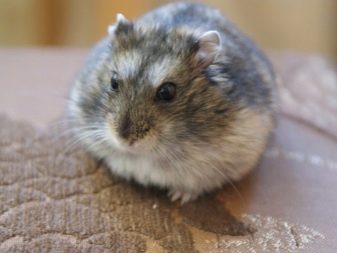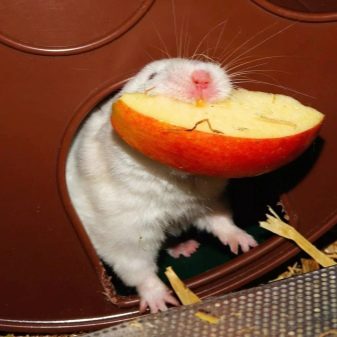All about white Dzungarian hamsters

When you want to have a quiet and easy-to-care pet, you should pay attention to the Dzungarian hamster. These cute little animals easily make contact, are friendly with people and do not require complicated care.

Description
The Dzungarian hamster is also called the Siberian hamster and the Dzungarik. It belongs to the family of upholstered hamsters, which is represented by only 3 representatives. In nature, these animals live in Western Siberia, in the north-west of China, on the territory of Mongolia and Kazakhstan.
Campbell's dwarf hamsters are very similar to dwarf hamsters. These two species can interbreed, resulting in hybrids. Such experiments are undesirable. Male dzungariks have a single gland, the work of which is responsible for creating a male scent. This gland is located below the abdomen, it often looks like a bulge and can be covered with oily discharge.


Albinos are rare among Dzungarian hamsters. In the wild, the Dzungarian hamster changes its fur coat to a white one, which allows it to camouflage itself in the snow and hide from predators.
At home, this feature is rare. Domestic dzungariki have a short life expectancy. Usually it is about 2 years old, only in rare cases a hamster can live for 4 years.

External characteristics
Dzhungariki differ from their close relatives Campbell hamsters in softer and smoother coat. And also the transition from the forehead to the nose is smoother. The Dzungarian hamster is also characterized by a number of the following external characteristics:
- there is a dark stripe on the back that runs along the entire ridge;
- the tail is small, almost invisible;
- the sole on all legs is shaggy;
- the head is rather large in comparison with the body, large black beady eyes are located on it;
- the shape of the body is round, the length varies within 7–10 cm;
- weight is in the range of 30–65 g;
- capacious cheek pouches;
- Dzungariki grab food with their front paws, as marmots do.

The color of domestic Dzungarian hamsters is very different from the fur coat that wild animals have. There are several options for the color of fur in domestic jungariks:
- "standard" represented by brown fur with a gray tint, on the belly the fur is white;
- "sapphire" identified by gray fur with a bluish tint and white belly;
- "pearl" - This is a matte coat with a white color, which is diluted with gray gaps;
- "mandarin" represented by a light red cream color.




Conditions of detention
The white Dzungarian hamster is a peaceful animal, which is not characterized by aggressive behavior. And yet, there should be only one animal in the cage, regardless of gender. Dzungariki are territorial hamsters, therefore, in a confined space, they can show aggression towards each other. Fighting can result in injury and even death.
This pet is ideal for home keeping, which is why it is so popular.

In order for a hamster to be healthy, to please its owner and not to become a source of problems, it is necessary to know and observe some of the features of the content.
- A dzhungarik needs a cage to live. It is undesirable to use an aquarium, since in such a design the ventilation is not good enough, and condensation may form on the walls. In such conditions, the hamster will feel bad.
Although the animal is small, the cage should be spacious. Even if you have only one hamster, the bottom of its cage should still not be less than 30X50 cm.


- Hay, sawdust, special filler are placed on the bottom, intended for rodents, or shavings from trees, but not conifers. And also toilet paper, napkins without staining and paper towels can be used as a bedding. It is strictly forbidden to use cotton wool.

- Dzungariki are prone to obesity, therefore they need physical activity. To do this, you need to place toys, tunnels, hammocks and a wheel with a diameter of more than 17 cm in the cage.


- Water procedures are contraindicated for these animals. But Dzungarian hamsters are very fond of sand baths. Digging in the sand, the animal cleans its coat of crumbs and small debris. Regular sand baths can help remove the greasy sheen from the coat and prevent unpleasant odors. Dzungariki are very clean.
For sand baths, you can use river or special sand, which is intended for chinchillas, and a container made of ceramic or metal.

- Dzhungariks constantly grow teeth that they need to grind down regularly... For these purposes, you can place a mineral pebble in the cage, branches of fruit trees (not cherry and apricot) or wooden blocks.


- These animals are nocturnal. For daytime rest, they need a house. And also in the cage it is necessary to arrange a feeder, a drinker and a toilet.


- The cage should be installed away from drafts and direct sunlight. And also it should not come into contact with wallpaper and curtains, as the animal will quickly chew them.


- The cage needs to be cleaned and washed regularly, the animal can get sick from unsanitary conditions... The same applies to food and water: they must always be fresh. The hamster can carry food to the house, this must be monitored and such caches must be cleaned regularly. After all, the food in the house can go bad, which will cause poisoning of the dzungarik. The feeder and drinker should not be cleaned with chemicals.


The diet
Pet stores offer a wide variety of ready-to-use mixtures for hamsters. The diet should not consist of only one mixture. For a change, you can add a number of products:
- grain crops (wheat, corn, sunflower seeds, rye);
- from vegetables, you can give carrots, pumpkins, cucumbers, zucchini;
- you should not get too carried away with fruits, sometimes you can offer your pet apples, bananas and apricots, only necessarily without seeds;
- only chicken and rabbit meat can be chosen from meat;
- boiled eggs (chicken, quail) can be included in the diet of dzungarian people;
- cottage cheese should only be fat-free;
- from greens, you can give plantain leaves and salad.


Each hamster requires an individual diet that will suit his preferences. The amount of food should be enough for a day. And also you must always remember about the food that should not be given to the pet:
- foods high in fat (butter, milk and cottage cheese with a high percentage of fat, veal, beef and pork);
- condiments and spices, including onions and garlic;
- sweets and foods that can freeze in the cheeks of the animal;
- exotic fruits and citrus fruits;
- semi-finished products, including sausages;
- raw potatoes are also banned;
- watermelons and melons.

Reproduction
In captivity, Dzungariki breed well. This requires compliance with some prerequisites:
- the female must be over 4 months old and the male must be over 3 months old;
- pregnancy lasts about 3 weeks, during this period protein foods (cottage cheese, breast and boiled yolk) must be included in the female's diet;
- during pregnancy and until the end of feeding, the female should be at rest;
- before childbirth - about 2 days before - disinfection is carried out in the cage, including all accessories and toys;
- during the first 3 weeks, the cubs feed on mother's milk, during this period it is strictly forbidden to pick them up, since a young mother can abandon her children and even eat them.


After 5 days from the moment of birth, the cubs become calmer and stop squeaking. On the 7th day of life, the body of the babies is covered with fur, and after 10 days they begin to make their first movements and try soft food. Dzungariks can be placed in a separate cage one month after birth.
Name
This point is worth paying attention to and taking the process of choosing a name seriously. A nickname for a rodent should be simple and sonorous. Often the name is chosen according to the pet's temperament, taste preferences or appearance. We have selected the most interesting and original variants of names for dzungariks:
- names for boys: Nut, Bagel, Fat Man, Zhora, Cupcake, Pirozhulya, Bobblehead, Ryzhik, Wales, Ruddy, Antoshka, Gray, Garfield, Black, Knight, Snowball, Umka;
- names for girls: Crumpet, Bun, Gourmet, Lady, Gadget, Seed, Crumb, Abrikoska, Toffee.

Selection Tips
When buying, it is important to choose a pet that is good in all respects, to do this, you need to use the advice from professionals:
- it is best to buy a pet between 5 and 6 weeks old;
- the hamster should be moderately active;
- if the health of the rodent raises even the slightest doubt, then the purchase should be abandoned;
- the coat should be free of bite marks and bald patches, and it should also be clean and dry;
- the eyes and nose should have a healthy appearance, without discharge and suppuration;
- near the anus, the coat should also be dry and clean.
All about Dzungarian hamsters, see the video below.








